Buttermilk
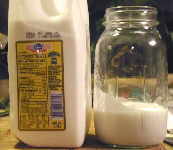
|
Making ButtermilkProfessor of Biology and Chemistry University of Cincinnati Clermont College, Batavia OH 45103 |
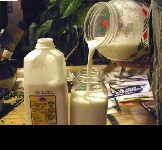
|
|
buttermilk as starter |
fresh milk to the starter |
Buttermilk is probably the easiest and most foolproof fermented milk product to make. All you need is active cultured buttermilk for the starter, and fresh milk for it to act on. The formation of buttermilk is based on the fermentation by the starter bacteria which turns lactose into lactic acid. As lactic acid is formed, the pH of the milk drops. Milk proteins, most notably casein, are no longer as soluble under acid conditions and they precipitate out, causing what we recognize as clabbering. Thus the two marked characteristics of buttermilk, its tartness and its thickened nature, are both explained by the presence of lactic acid. Additional byproducts of fermentation give subtle variations in buttermilk flavor.
The acidity of buttermilk also explains its long refrigerator shelf life. Acid is a natural preservative because it inhibits the growth of pathogenic bacteria. Thus buttermilk keeps easily for weeks in your refrigerator. If you keep it longer, it may develop mold on the inner walls of the jar. This mold belongs to the same group which grow on cheese and is not dangerous. Remove it and the buttermilk can still be used for baking. However, because the bacteria may have died in older samples, buttermilk older than three to four weeks may not work as an inoculum to make buttermilk.
INGREDIENTS AND EQUIPMENT:
6-8 ounces active cultured buttermilk
Check the label: needs to say cultured buttermilk, and is not out of date. (the bacteria die down over time)
3 cups whole milk (skimmed will doubtless work, but I have not tried it)
very clean 1 quart container with secure lid (I prefer Mason jars).
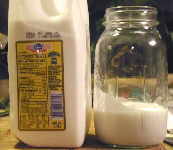
|
Add 6 to 8 ounces of active fresh cultured buttermilk (starter) to a clean quart jar. Use 6 ounces if you are certain of the freshness of the starter (a ratio of about 1 part starter plus 4 parts milk). When in doubt, use the full cup of buttermilk as starter (a ratio of 1 part starter plus 3 parts milk). |
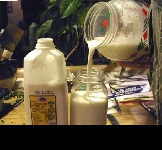
|
Fill the jar with fresh milk. |
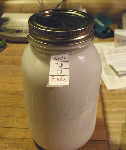
|
Screw on the lid securely and shake to mix thoroughly. Label with the date |
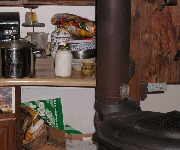
|
Let sit at in a warm part of the room (here next to our wood stove) until clabbered. It should be thickened in 24 hours. If it takes longer than 36 hours, the starter was no longer active (bacteria had died). |
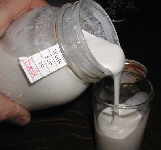
|
24 hours later (at room temperature), the bacteria have fermented the milk, the lactic acid causing the milk proteins to clabber. |
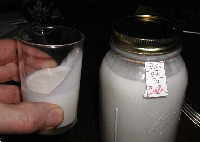
|
In the finished buttermilk, you can see how it coats the glass. The finished buttermilk should be refrigerated. It keeps easily for weeks. Fresher buttermilk makes better starter for cheese. |
I have received numerous requests for how to make buttermilk from scratch. For this, you need fresh raw milk because pasteurization destroys the needed bacteria.
Previous Email fankhadb@uc.edu